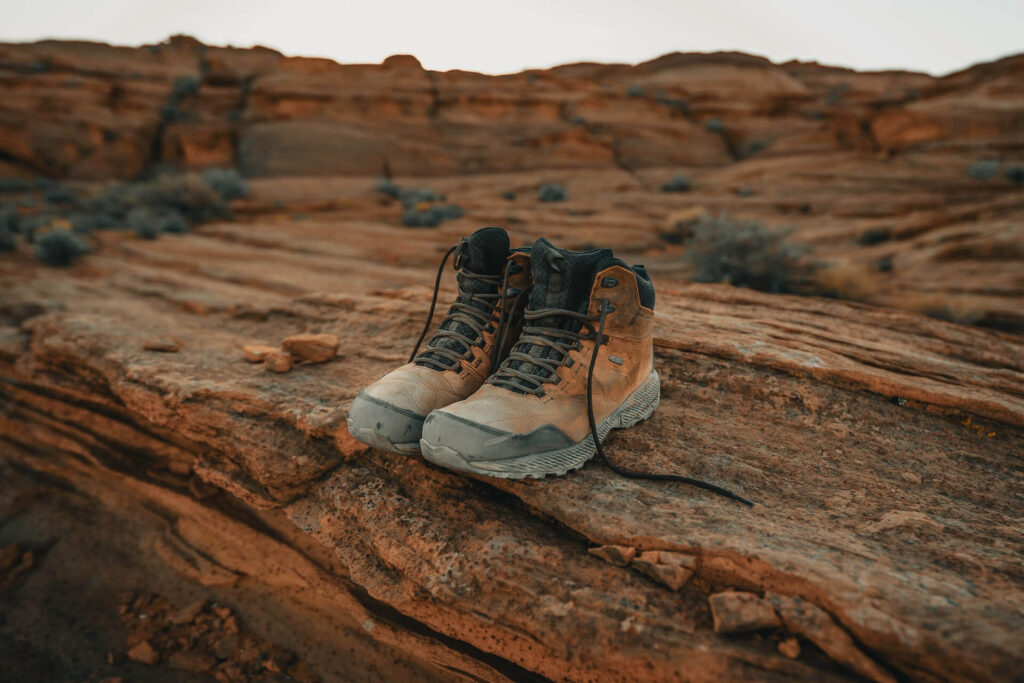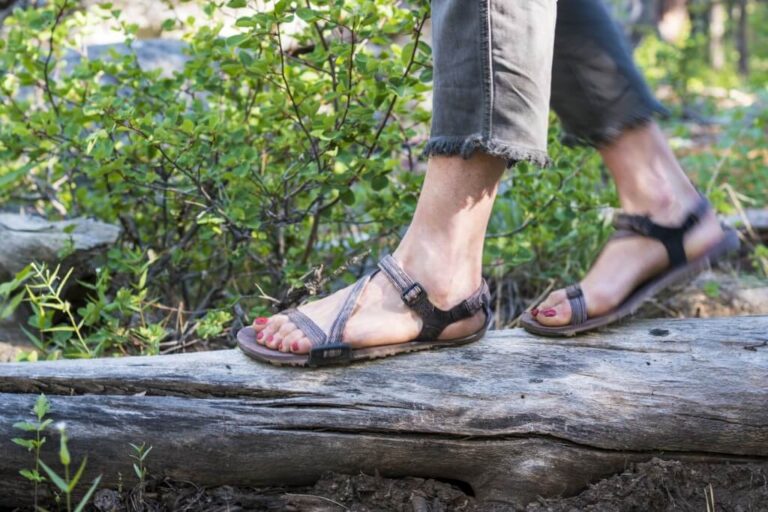
Introduction: Importance of Choosing the Right Hiking Boots for Your Feet
Hiking boots are not just regular shoes; they are specialized footwear designed to provide the necessary support, protection, and traction needed for outdoor adventures like hiking. Choosing the right hiking boots for your feet is crucial for a variety of reasons, including comfort, safety, and overall foot health.
Understanding the Role of hiking boots in outdoor adventures
Hiking involves navigating through various terrains such as rocky trails, muddy paths, and steep slopes, which can put a lot of strain on your feet. Hiking boots are designed with features like durable outsoles, supportive midsoles, and ankle support to provide stability and protection against rough terrains. They are also typically waterproof or water-resistant, keeping your feet dry and comfortable even in wet conditions. Proper hiking boots are essential in providing the necessary support and protection to prevent injuries and discomfort during your outdoor adventures.
Why proper fit is crucial for comfort and safety
The fit of your hiking boots is perhaps the most critical factor in ensuring comfort and safety during your hikes. Ill-fitting hiking boots can cause blisters, hot spots, and foot pain, making your hiking experience miserable. On the other hand, properly fitting hiking boots provide the right amount of cushioning, support, and stability, allowing you to hike for longer durations without discomfort.
Know Your Feet: Assessing Your Foot Type and Needs
Before choosing, it’s essential to assess your foot type and needs to ensure the right fit and comfort. Understanding your foot shape, size, arch type, any specific foot conditions or concerns you may have, and how these foot characteristics affect boot selection is crucial in finding the perfect pair of hiking boots.
Determining your foot shape, size, and arch type
Start by measuring your foot size accurately. Use a brannock device or a ruler to measure the length and width of your feet while standing. Remember to measure both feet as they may be slightly different in size. Knowing your foot size will help you choose the right size of hiking boots that provide enough room for your toes to move comfortably without being too loose.
Next, consider your foot shape and arch type. Feet can be categorized into three main types of arches: high, medium, and low. You can determine your arch type by conducting a “wet test” or consulting with a podiatrist. Understanding your arch type is crucial as it affects the amount of support and cushioning needed from your hiking boots. For example, those with high arches may need boots with more arch support, while those with low arches may need boots with more cushioning to provide proper support and prevent discomfort during hikes.
Considering any specific foot conditions or concerns
If you have any specific foot conditions or concerns, such as bunions, hammertoes, or plantar fasciitis, it’s important to take them into consideration when choosing hiking boots. Certain foot conditions may require special features or modifications in hiking boots to provide the necessary support and comfort. For example, boots with a wider toe box may be suitable for those with bunions or hammertoes, while boots with excellent shock absorption may be beneficial for those with plantar fasciitis.
Understanding how foot characteristics affect boot selection
Your foot characteristics, including size, shape, arch type, and any foot conditions or concerns, should all be considered when selecting hiking boots. For example, if you have wider feet, you may need to look for hiking boots with a wider toe box to prevent discomfort and blisters. If you have flat feet, you may require boots with good arch support to provide stability and reduce the risk of overpronation. Understanding how your foot characteristics affect boot selection is crucial in finding the right fit and comfort for your feet during your hiking adventures.

Types of Hiking Boots: Understanding the Options
When it comes to hiking boots, there are several different styles to choose from, including hiking shoes, hiking boot, and backpacking boots. Understanding the differences and pros and cons of each type of hiking boot is crucial in making the right choice for your feet.
Exploring different styles of hiking boots: hiking shoes, hiking boots, backpacking boots
Hiking Shoes: Hiking shoes are lightweight and low-cut, resembling athletic shoes. They are perfect for day hikes or shorter trails with well-maintained paths. Hiking shoes provide good traction, flexibility, and breathability, making them suitable for warm weather and less technical terrain. They are also a great option for hikers who prefer a lighter and more agile feel on the trail.
Hiking Boots: These are mid-cut or high-cut, providing more ankle support and stability compared to hiking shoes. They are suitable for a wide range of terrains, including rough trails, uneven surfaces, and rocky terrain. Hiking boots typically offer more protection and durability, making them ideal for longer hikes, backpacking trips, or challenging terrain. They also provide better insulation and waterproofing, making them suitable for varied weather conditions.
Backpacking Boots: Backpacking boots are the most rugged and sturdy type of hiking boots, designed for extended backpacking trips or challenging terrains. They are high-cut and offer excellent ankle support, stability, and protection. Backpacking boots are suitable for hikers carrying heavy loads, traversing rough trails, or encountering harsh weather conditions. They provide maximum support and durability, but they are also heavier and less flexible compared to hiking shoes or hiking boots.
Pros and cons of each type of hiking boot
Hiking shoes:
- Pros: Lightweight, flexible, and breathable; suitable for warm weather and less technical trails; offer a more agile feel on the trail.
- Cons: Less ankle support and protection; not suitable for rough terrains or heavy loads.
Hiking boots:
- Pros: Provide ankle support, stability, and protection; suitable for a wide range of terrains; offer better insulation and waterproofing; durable.
- Cons: Heavier compared to hiking shoes; may feel less agile on the trail.
Backpacking boots:
- Pros: Provide maximum ankle support, stability, and protection; suitable for extended backpacking trips or challenging terrains; durable.
- Cons: Heavier and less flexible compared to hiking shoes or hiking boots; may feel bulky on the trail.
Factors to consider when choosing the right type of hiking boot for your feet
When choosing the right type of hiking boot for your feet, there are several factors to consider:
- Terrain: Consider the type of terrain you will be hiking on. For well-maintained trails or warm weather, hiking shoes may be suitable. For rough trails or challenging terrains, hiking boots or backpacking boots may be more appropriate.
- Duration: Consider the duration of your hikes. For shorter day hikes, hiking shoes may be sufficient. For longer hikes or backpacking trips, hiking boots or backpacking boots may provide better support and protection.
- Load: Consider the weight of your backpack. If you will be carrying a heavy load, backpacking boots may be necessary to provide the needed support and stability.
- Weather: Consider the weather conditions of your hiking destination. If you will be hiking in wet or cold conditions, hiking boots or backpacking boots with good insulation and waterproofing may be required.
- Foot type and comfort: Consider your foot type, size, shape, arch type, and any specific foot conditions or concerns. Different types of hiking boots may provide different levels of support and comfort for your feet, so choose the one that suits your foot characteristics the best.

Getting the Right Fit: Sizing and Trying on Hiking Boots
Choosing the right size and fit for your boots is crucial for comfort, stability, and preventing foot-related issues on the trail. Hiking boot sizing is slightly different from regular shoe sizing, and it’s important to understand how to measure your feet accurately and try on hiking boots properly.
Understanding hiking boot sizing and how it differs from regular shoe sizing
These are designed to provide ample support and protection for outdoor adventures, and their sizing may differ from regular shoes. Hiking boots are often sized in US, UK, or EU sizes, and it’s essential to refer to the specific sizing chart provided by the manufacturer or retailer. It’s important to note that hiking boots may have a different fit compared to your regular shoes, and it’s recommended to try them on before purchasing.
Tips for measuring your feet accurately
Measuring your feet accurately is crucial in finding the right size of hiking boots. Here are some tips to measure your feet accurately:
- Measure your feet at the end of the day: Feet tend to swell throughout the day, so it’s best to measure them at the end of the day when they are at their largest.
- Use a Brannock device or a ruler: Use a Brannock device or a ruler to measure the length and width of your feet. Place your foot on the device or ruler and measure from the heel to the longest toe for length, and measure across the widest part of your foot for width.
- Measure both feet: It’s common for one foot to be slightly larger than the other. Measure both feet and use the larger measurement to determine your size.
- Consider socks: Wear the socks that you plan to wear with your hiking boots when measuring your feet, as this can affect the fit.
Trying on hiking boots in-store or ordering online with proper fitting techniques
Once you have measured your feet accurately, it’s time to try on hiking boots to ensure the right fit. If possible, it’s best to try on hiking boots in-store to have a hands-on experience and get a feel for the fit. Here are some tips for trying on hiking boots:
- Wear the right socks: Wear the socks that you plan to wear during your hikes to ensure a proper fit. Thick hiking socks are recommended for better cushioning and moisture-wicking.
- Lace up properly: Lace up the hiking boots properly, ensuring a snug fit but not too tight. Make sure the boots are laced evenly and that your feet feel secure and comfortable inside.
- Walk around: Walk around the store or on a flat surface to test the fit and comfort of the hiking boots. Pay attention to any pressure points or discomfort, especially in the toe box and heel area.
- Check for toe room: Make sure there is enough toe room in the hiking boots. Your toes should have enough space to wiggle, and there should be a thumb’s width of space between your longest toe and the front of the boot.
If trying on hiking boots in-store is not possible, you can also order online, but it’s important to follow the sizing chart provided by the manufacturer or retailer and consider the return policy in case the fit is not suitable.
Evaluating Features: What to Look for in Hiking Boots
When choosing the right hiking boots for your feet, it’s important to evaluate the features of the boots to ensure they meet your specific needs and the requirements of your hiking adventures. Here are some key features to look for in hiking boots:
Sole and traction: understanding different types of soles and their suitability for different terrains
The sole of a hiking boot plays a critical role in providing traction and stability on different types of terrain. Different hiking boots may have different types of soles, including rubber, Vibram, or other proprietary materials. It’s important to understand the different types of soles and their suitability for different terrains. For example, a more aggressive lug pattern with deeper grooves may be suitable for muddy or rocky terrains, while a shallower lug pattern may be ideal for dry, packed trails. Consider the type of terrain you will be hiking in and choose a sole that provides the appropriate level of traction for your needs.
Material and construction: assessing durability, breathability, and waterproofing
The material and construction of hiking boots can greatly impact their durability, breathability, and waterproofing capabilities. Common materials used in hiking boots include leather, synthetic materials, or a combination of both. Leather hiking boots are known for their durability and support, but they may be heavier and require more break-in time. Synthetic materials, on the other hand, are generally lighter and more breathable, but they may not be as durable as leather.
In addition to the materials used, it’s important to consider the construction of the hiking boots. Look for reinforced toe caps and heel counters for added durability and protection. Waterproofing is also a crucial feature, especially if you plan to hike in wet or damp conditions. Hiking boots may have waterproof membranes, such as Gore-Tex or eVent, that provide protection against moisture while allowing for breathability. Consider the level of waterproofing needed based on the type of hikes you plan to do and the weather conditions you may encounter.
Support and stability: considering ankle support, midsole stiffness, and overall comfort
The level of support and stability provided by hiking boots can greatly impact your comfort and safety on the trail. Ankle support is an important consideration, as it helps prevent ankle injuries on uneven terrain. Hiking boots may have low-cut, mid-cut, or high-cut designs, each offering different levels of ankle support. Choose a design that provides the appropriate level of ankle support based on your hiking style and preferences.
The stiffness of the midsole is another important factor to consider. A stiffer midsole provides more support and stability, which is beneficial for rocky or uneven terrains. However, a stiffer midsole may also sacrifice some flexibility and comfort. On the other hand, a softer midsole offers more flexibility and comfort, which is ideal for less technical trails. Consider the level of support and stability needed based on the type of hikes you plan to do and the conditions you may encounter.
Overall comfort is paramount when choosing hiking boots. Look for boots with cushioned insoles, padded collars, and ample toe room to ensure a comfortable fit. It’s recommended to try on hiking boots and walk around in them to assess their comfort level. Keep in mind that comfort is subjective, and what may be comfortable for one person may not be for another. Choose hiking boots that feel comfortable on your feet and provide the necessary support and stability for your hiking adventures.
5 Popular Hiking Boots for You

1. Merrell Moab 2 Mid Waterproof Hiking Boots:
The Merrell Moab 2 Mid Waterproof Hiking Boots are a popular choice among hikers for their comfort, durability, and versatility. These boots feature a waterproof membrane that keeps your feet dry in wet conditions, while the breathable mesh lining ensures proper ventilation. The Merrell air cushion in the heel absorbs shock and provides stability, and the Vibram TC5+ outsole delivers excellent traction on various terrains. The Moab 2 Mid also has a supportive midsole and a protective toe cap, making it suitable for day hikes and moderate backpacking trips.
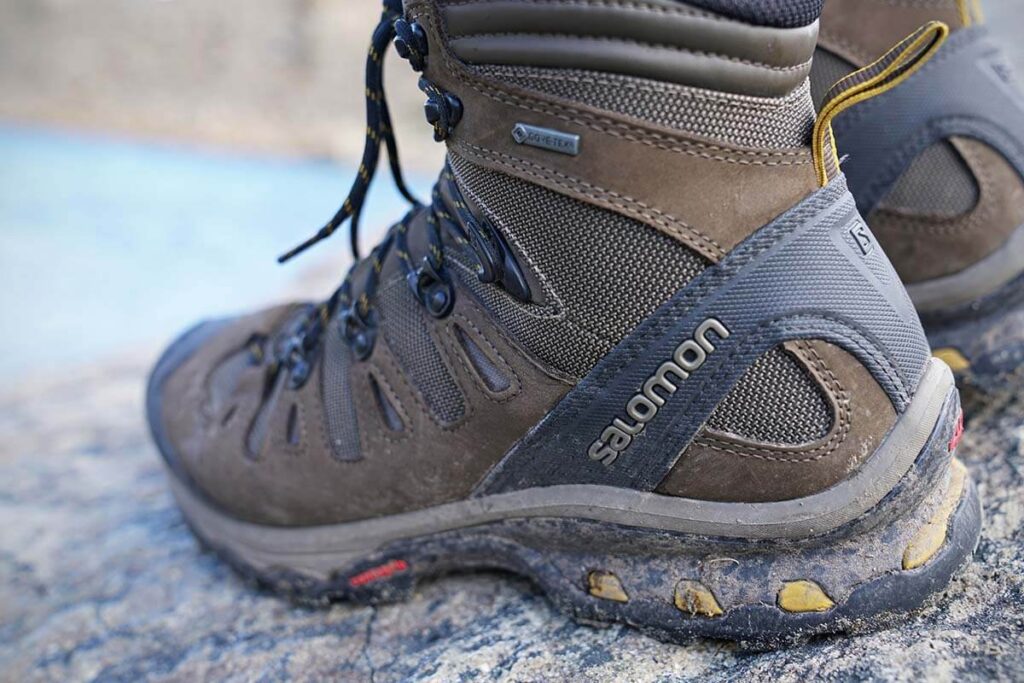
2. Salomon Quest 4D 3 GTX Hiking Boots:
The Salomon Quest 4D 3 GTX Hiking Boots are known for their performance and support on the trails. These boots feature a durable and waterproof Gore-Tex membrane that keeps your feet dry in wet conditions, and the Contagrip outsole provides exceptional traction on both wet and dry surfaces. The 4D Advanced Chassis system offers stability and protection, and the Ortholite sockliner provides cushioning and comfort. The Quest 4D 3 GTX also has a high-cut design for ankle support and is suitable for backpacking and rugged terrain.
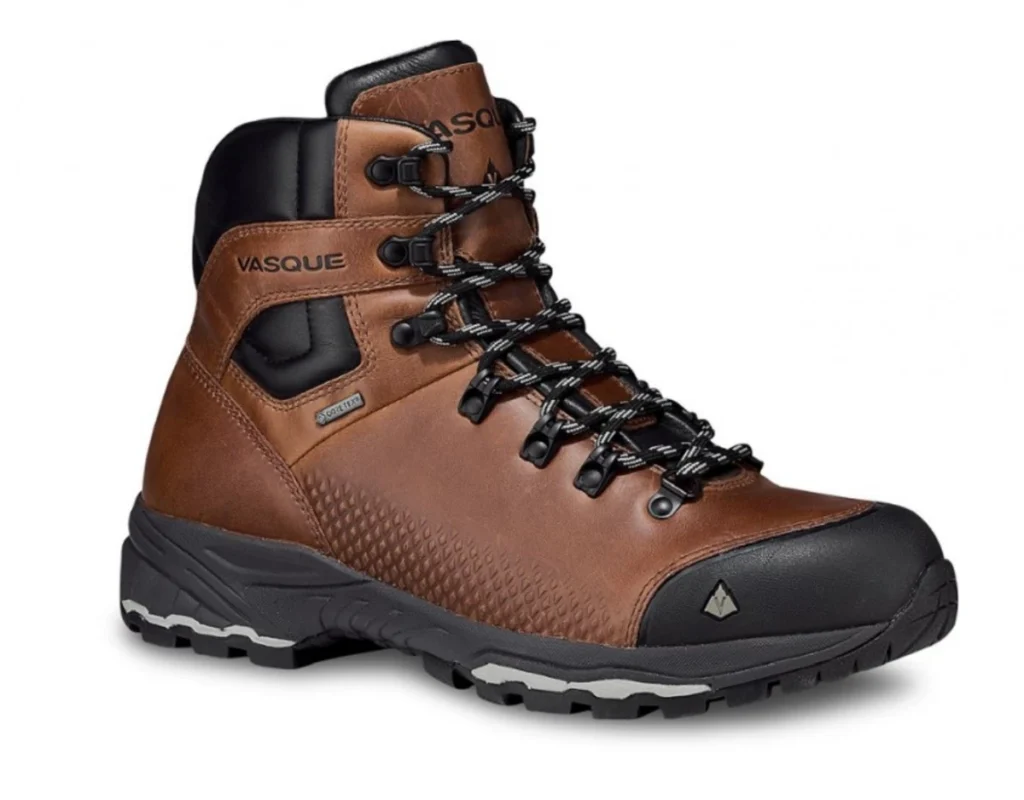
3. Vasque St. Elias FG GTX Hiking Boots:
The Vasque St. Elias FG GTX Hiking Boots are a popular choice among backpackers and hikers who prioritize comfort and support. These boots feature a full-grain leather upper for durability and a waterproof Gore-Tex membrane for protection against the elements. The Vibram Frontier outsole provides excellent traction, and the dual-density EVA footbed offers cushioning and stability. The St. Elias FG GTX also has a padded collar and tongue, as well as a cushioned midsole, for added comfort during long hikes.

4. Keen Targhee III Mid Waterproof Hiking Boots:
The Keen Targhee III Mid Waterproof Hiking Boots are known for their ruggedness and versatility. These boots feature a waterproof leather and mesh upper, along with a Keen.Dry membrane that keeps your feet dry and comfortable in wet conditions. The Keen All-Terrain rubber outsole provides superior traction, and the ESS shank offers stability and support. The Targhee III Mid also has a cushioned footbed and a padded collar for all-day comfort, and the Keen.Protect toe cap provides added durability and protection on the trails.
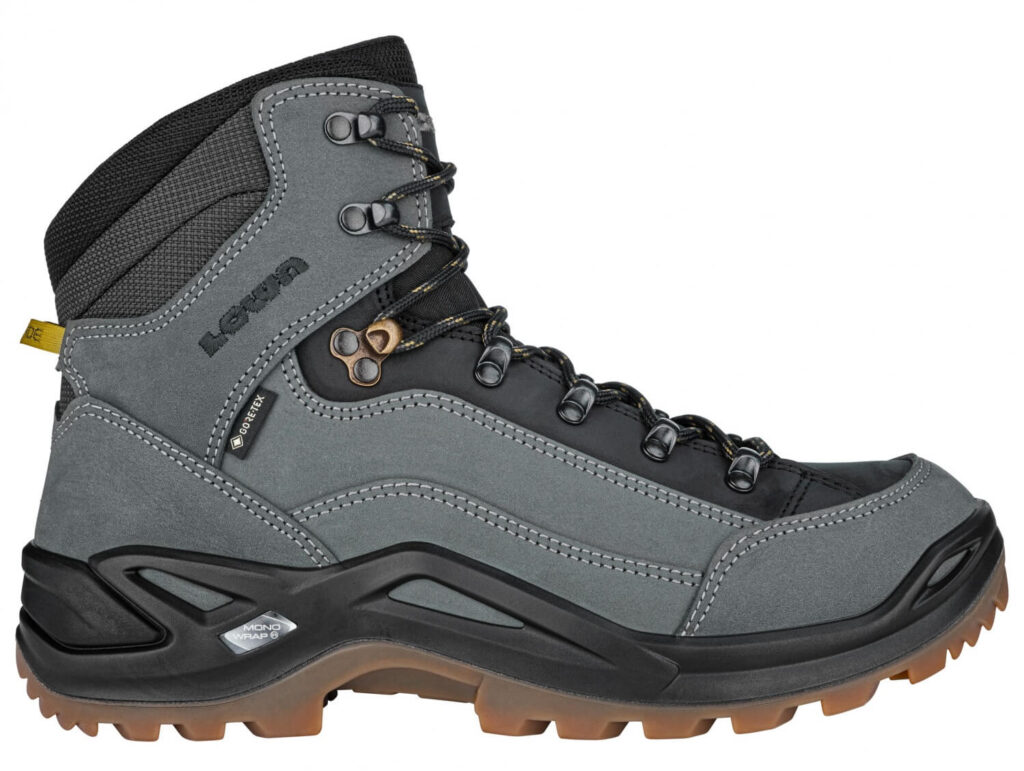
5. Lowa Renegade GTX Mid Hiking Boots:
The Lowa Renegade GTX Mid Hiking Boots are a popular choice for hikers who prioritize comfort and performance. These boots feature a waterproof and breathable Gore-Tex lining that keeps your feet dry in wet conditions, and the Vibram Evo outsole offers excellent traction on various terrains. The Monowrap frame construction provides stability and support, and the Climate Control footbed wicks away moisture for added comfort. The Renegade GTX Mid also has a padded collar and tongue, as well as a supportive midsole, making it suitable for long hikes and backpacking trips.
Taking Care of Your Hiking Boots: Maintenance and Care Tips
Investing in a good pair of hiking boots is essential, and taking proper care of them will help prolong their lifespan and ensure they continue to perform well on the trails. Here are some maintenance and care tips for your hiking boots:
Proper Cleaning and Drying Techniques: After each hike, it’s important to clean your hiking boots properly to remove dirt, debris, and mud that may have accumulated on them. Use a soft brush or cloth to gently clean the uppers, soles, and laces. Avoid using harsh chemicals or abrasive materials that may damage the boot’s materials. Once cleaned, allow your boots to air dry in a well-ventilated area, away from direct sunlight or heat sources. Do not use artificial heat sources like heaters or dryers as they can cause the boots to shrink or warp.
Storage Tips: Proper storage of your hiking boots is important to prevent them from getting damaged. Store them in a cool, dry place, away from direct sunlight and extreme temperatures. Avoid storing them in a damp or humid area as it can promote the growth of mold or mildew. Stuffing the boots with newspaper or using boot trees can help maintain their shape and prevent them from developing creases or wrinkles.
Addressing Common Issues: Blisters, odor, and wear and tear are common issues with hiking boots. To prevent blisters, make sure your boots fit well and wear moisture-wicking socks to reduce friction. If you do develop blisters, treat them promptly with blister pads or moleskin to prevent further irritation. To address odor, allow your boots to dry thoroughly after each use, and use odor-reducing sprays or powders if needed. To manage wear and tear, regularly inspect your boots for any signs of damage or wear, such as loose stitches or worn-out soles, and address them promptly to prevent further damage.
Waterproofing: If your hiking boots are not already waterproof, consider applying a waterproofing treatment to protect them from moisture and keep your feet dry during wet hikes. Follow the manufacturer’s instructions on the waterproofing product and reapply as needed, especially after extended use or exposure to harsh weather conditions.
Resoling and Repairing: Over time, the soles of your hiking boots may wear out, and the uppers may develop holes or tears. It’s important to address these issues promptly to extend the lifespan of your boots. Some hiking boot brands offer resoling or repairing services, or you can take them to a professional cobbler for repairs. Avoid using adhesive or DIY fixes that may compromise the structural integrity of the boots.

Conclusion: Choosing the Perfect Hiking Boots for Your Feet
In conclusion, choosing the right hiking boots for your feet is of paramount importance for a comfortable and safe outdoor adventure. Understanding your foot type and needs, evaluating different types of hiking boots, getting the right fit, and considering features like sole traction, material, construction, support, and stability are crucial factors to consider when selecting hiking boots. Additionally, knowing about popular hiking boot options from reputable brands can provide you with a starting point for your research.
Furthermore, taking care of your hiking boots through proper maintenance and care is equally vital to ensure they last for a long time and continue to perform well on the trails. Regular cleaning, proper storage, addressing common issues, waterproofing, and timely repairs are essential steps to keep your hiking boots in good condition.
By investing in the right hiking boots and taking proper care of them, you can enjoy comfortable and safe hikes, treks, and adventures in the great outdoors. So, gear up with the right hiking boots that fit well, suit your foot type and needs, and take the necessary steps to maintain and care for them. Your feet will thank you, and you’ll be ready for your next thrilling outdoor escapade! Happy hiking!
Read more articles here.
